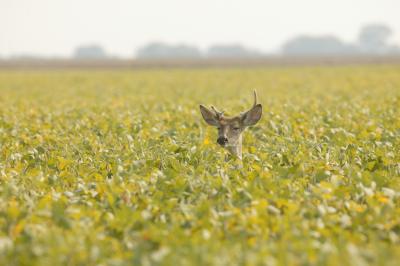Everyone always wants to know what the best food plot seeds to plant are. And it’s always difficult to answer with the hundreds of seed choices available, and the untold number of weather, soil, habitat and precipitation variables that come into play. So we’ll break down just some of the top contenders that work well in a wide range of conditions.
QUICK TIPS FOR FOOD PLOT SEEDS AND PLOT SIZES

Forage soybeans are one of the top choices for warm-season annuals because of their high protein value and fast growing rates.
Warm-Season Annual Food Plot Seeds
Right now is the time to get these plants in the ground. They yield tons of forage until frosts arrive, but require replanting each year and most do best in quality soils with heavy amounts of fertilizer. These annuals tolerate summer’s dry conditions well, have high protein levels and are highly palatable.
Though they yield 4 to 7 tons of forage per acre, seasonal availability limits their chance to win the overall food plot competition with just six to seven months of production typical. The vulnerability of young plants is also a negative. Most of these must be protected for about four weeks with electric fences or repellent-soaked ribbon to keep deer from destroying them unless large acreages are planted.
HOW TO CREATE YEAR-ROUND FORAGE IN YOUR FOOD PLOTS
Planting dates: April-July
Cow peas: Originating in Ethiopia, cow peas rate high for palatability and pack plenty of protein, at 20 to 28 percent. They also tolerate poor, sandy soil, but require liming if the pH is below 5.5. They won’t produce the tonnage of food the best forage soybean varieties do, and won’t bounce back as well from over-browsing as lablab. These drawbacks put them at the back of the legume pack.
Lablab: This bean, originally from Africa, is extremely drought tolerant and first became popular in Texas for this quality. Leaves are larger than cowpeas and it grows faster when fertilized. Lablab produces higher protein levels (21 to 35 percent) and persists longer than cowpeas into fall. Deer love its taste. Rank: a notch above cowpeas.
Sunn Hemp: This plant came from India and dates back to 600 B.C. It grows as tall as 11 feet with high protein levels — up to 30 percent. Sunn hemp is drought-tolerant and comes back strong even after heavy browsing.
Sunn hemp is a soil builder that recycles over 100 pounds of nitrogen, 80 pounds of potash and 20 pounds of phosphorous from subsoil levels, drawing them out and leaving them in the topsoil for future crops. It also releases chemicals that suppress weeds and harmful nematodes. The fibrous residue from the stalks, though, is sometimes a nuisance to get rid of, and deer don’t like the taste quite as well as lablab or soybeans. Good stuff, but not the winner.
Forage Soybeans: These are grown for their tender, high-protein leaves. Several varieties, such as Eagle Seed’s Large Lad and Big Fellow, have been created to provide green forage longer into fall than most soybeans and produce massive growth up to 7 feet tall from the deep-rooted, drought-tolerant plants.
Deer often bed right in fields of forage soybeans, finding both food and ample cover without moving. Forage production typically lasts seven to eight months. Palatability rates a 10, with protein levels in the 30s to low 40s.
Top Food Plot Seeds Winner: Forage soybeans. Runner-up, tie: sunn hemp and lablab.
_______________________________
[embedded content]

